2. 动物抗病营养教育部重点实验室, 成都 611130
2. Key Laboratory of Animal Disease-Resistance Nutrition, Ministry of Education, Chengdu 611130, China
母猪养殖过程中,繁殖性能的高低是决定猪场盈利能力和生产效率高低的关键。饲粮营养是保证母猪繁殖效率的基础,其中能量和蛋白质原料占饲料总成本的90%以上。随着养殖业的快速发展,我国饲料资源出现了严重紧缺,能量饲料和蛋白质饲料价格持续攀升,养殖成本不断增加。因此,高效利用能量和蛋白质饲料资源,精准配制母猪饲粮,降低母猪饲料成本成为行业关注的焦点。本文综述了本实验室和其他国内外母猪营养领域专家的研究成果,系统分析了能量与蛋白质水平、来源和氨基酸对母猪繁殖性能的影响及可能调控机制,为母猪能量与蛋白质精准营养研究和饲粮配制提供重要依据。
1 母猪能量营养研究进展 1.1 饲粮能量水平对母猪繁殖性能的影响随着我国母猪繁殖力的不断提高,母猪对能量的需要量也在发生改变。30年前母猪能量需要量主要采用消化能(DE)体系,而目前主要采用代谢能(ME)和净能(NE)体系。图 1总结了13篇饲粮不同能量水平对妊娠和泌乳母猪繁殖性能的影响[1-13]。从图 1可知,在妊娠期,随着饲粮ME水平的提高,母猪产仔数降低,仔猪初生重有升高的趋势,且妊娠母猪饲粮ME水平大多为12.55~13.39 MJ/kg;在泌乳期,随着ME水平的升高,断奶头数以及仔猪断奶重增加,泌乳母猪饲粮ME水平大多为13.39~14.23 MJ/kg。进一步研究发现,饲粮能量摄入量会影响到母猪的使用年限[14]。妊娠期能量摄入不足则会降低分娩和断奶时母猪体脂储备,不利于断奶后发情以及受孕。然而,饲粮能量水平(DE水平分别为29.9、33.1、36.6 MJ/d)升高,将直接影响母猪繁殖寿命,使得母猪完成4个繁殖周期的比例(29%、24%和16%)显著降低[15]。因此,母猪适宜水平的能量摄入对于母猪单胎以及终身繁殖力具有重要影响。然而,由于母猪终身繁殖力研究的周期长、难度大等特点,当前的研究主要集中在饲粮能量水平对单胎次母猪繁殖性能的影响,对连续多胎次母猪终身繁殖力的研究十分缺乏,母猪单胎的能量需要是否适用于终身繁殖力的需要,仍亟需证实。
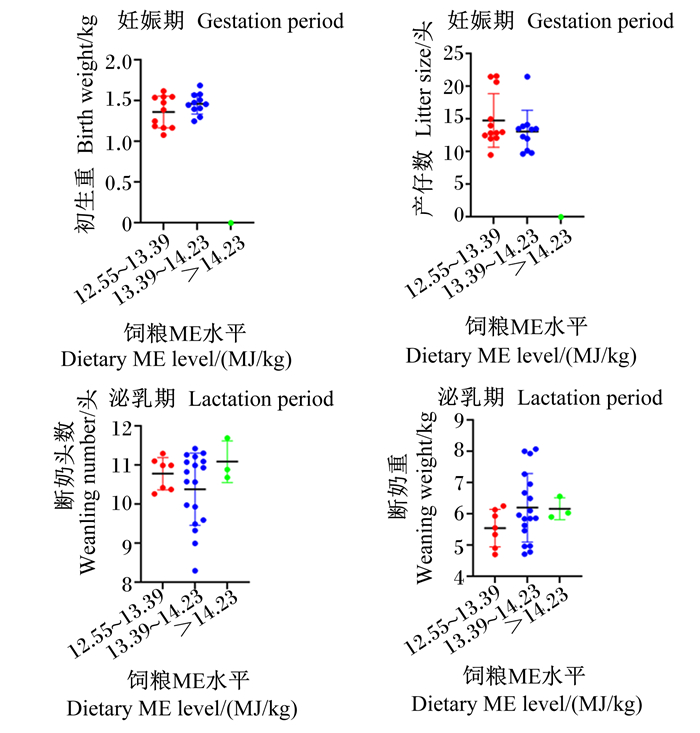
|
图 1 饲粮ME水平对母猪繁殖性能的影响 Fig. 1 Effects of dietary ME level on reproductive performance of sows |
母猪饲粮中的能量主要来源于碳水化合物(CHO),少量来源于脂肪。CHO在常规养分分析中属无氮浸出物和粗纤维范畴,来源广、成分杂,根据消化代谢差异分为2类:一是可被动物分泌的内源酶消化的CHO(如淀粉等),消化产物以葡萄糖为主;二是内源酶不可消化的CHO,以微生物消化方式为主,产物包括乙酸、丙酸、丁酸等短链脂肪酸(SCFAs)。饲粮中的粗脂肪主要包括植物油和动物油两大类。组成脂肪的脂肪酸分为饱和脂肪酸与不饱和脂肪酸,其主要作用为供给能量、提供必需脂肪酸、促进脂溶性维生素吸收等。
1.2.1 淀粉对母猪繁殖性能的影响饲粮中的淀粉主要来源于谷实类饲料,且不同来源淀粉中支链和直链淀粉的比例存在差异。淀粉的消化性与支链淀粉含量呈正相关,与直链淀粉含量呈负相关,支链淀粉在前肠被快速酶解消化,直链淀粉不易被消化酶水解,主要在后肠发酵[16]。表 1汇总了淀粉对母猪繁殖性能的影响[17-26],从表中可以看出,淀粉供给水平以及比例可显著影响母猪繁殖性能。后备母猪饲粮中淀粉水平(37.13%)过低不利于初情期启动[18];相同能量水平下,富含淀粉的饲粮有利于卵泡发育[19]。妊娠期母猪饲喂高淀粉以及高淀粉/脂肪比例饲粮可减少死胎数,改善初生重和新生仔猪的脂质代谢[21-22]。妊娠期和泌乳期饲喂高淀粉饲粮可以降低死胎率和断奶前死亡率[25-26],而且高直链淀粉比例可以提高乳脂率以及增加肠道菌群丰富度,提高泌乳期母猪采食量,改善断奶体况[23-24]。由此可见,适当提高母猪饲粮中淀粉水平以及直链淀粉比例对母猪繁殖性能更有益。
|
|
表 1 淀粉对母猪繁殖性能的影响 Table 1 Effects of starch on reproductive performance of sows |
纤维是母猪饲粮的重要组成部分,表 2汇总了纤维对母猪繁殖性能的影响[27-37]。在母猪营养上,纤维主要在母猪后备期和妊娠期发挥重要作用。从饲粮类型来看,北美的玉米+豆粕型饲粮中膳食纤维含量为11%~13%,不可溶纤维(ISF)和可溶性纤维(SF)含量分别为10%~11%和1%~2%,ISF/SF比例为8~11。欧洲的玉米+小麦+豆粕型饲粮中纤维含量为14%~17%、ISF含量为11%~13%、SF含量为2%~4%、ISF/SF比例为3~5。通过观察连续4胎次纤维对母猪繁殖性能的影响得出,对于初产母猪,可调整妊娠期饲粮中ISF/SF比例为3.89;对于第2~4胎母猪,可调整妊娠期饲粮中ISF/SF比例为5.59[38]。然而,由于纤维来源和纤维结构的复杂性,部分研究结果存在不一致的观点,且有关纤维的深入作用机制仍有待于进一步研究。
|
|
表 2 纤维对母猪繁殖性能的影响 Table 2 Effects of fiber on reproductive performance of sows |
脂肪对母猪的作用主要集中在妊娠后期-泌乳期或泌乳期,添加效果受遗传、营养、胎次、环境温度和管理等多种因素的影响。Wang等[39]对检索到的1986年至2020年发表的19篇脂肪对母猪繁殖性能影响的文章进行了Meta分析,发现妊娠后期和泌乳期母猪饲粮中添加脂肪降低采食量,增加总能量摄入,但对活产仔数、母猪体重损失没有显著影响。脂肪的添加可以提高乳脂含量,缩短断奶至发情时间间隔,且对低出生重仔猪以及泌乳期体况损失较多的母猪来说补充脂肪有积极效应;同时,热应激下,补充脂肪有利于提高母猪能量摄入量和仔猪生长性能。事实上,母猪饲粮添加脂肪,一方面可缩短母猪断奶至发情间隔3.65 d[40];另一方面可增加母猪分娩时血液催乳素浓度,改善母猪初乳中养分含量[34]。妊娠第107天至泌乳期第21天在饲粮中分别添加不同种类油脂,发现添加大豆油可提高母猪初乳中脂肪含量和血浆中C18∶2n-6和C18∶3n-3含量,并提高了母猪和仔猪血浆中的免疫球蛋白含量;仔猪血浆中脂肪酸的模式与母乳中相似;添加鱼油可降低母猪泌乳期背膘损失率,并通过增加乳脂产量和免疫球蛋白G(IgG)和免疫球蛋白M(IgM)的分泌来改善仔猪的生长性能[41]。Lauridsen等[42]研究显示,围产期至断奶母猪饲粮中添加8%动物脂肪或植物油均显著改善了窝增重,但鱼油的添加效果比植物油差。值得一提的是,尽管妊娠后期和泌乳期添加棕榈油可减少母猪泌乳期体重损失,增加乳脂含量,但是会导致泌乳期血糖水平升高,可能会加剧葡萄糖代谢的失衡[43]。因此,母猪饲粮中脂肪的应用时应充分考虑油脂的种类和添加水平。多不饱和脂肪酸(PUFA)在调节脂质代谢、促进生长发育和炎性调节中均具有重要的生理功能。Webel等[44]和Spencer等[45]研究表明,母猪饲粮添加n-3 PUFA可提高窝产仔数。增加母猪妊娠后期和泌乳期饲粮中n-3 PUFA比例可改善保护机制中有关应激增加的蛋白质[46],同时母猪饲粮中不同n-6∶n-3 PUFA比例也会影响乳源性细胞外囊泡蛋白质组[47]。改变泌乳母猪饲粮中n-6∶n-3 PUFA比例(3∶1、9∶1和13∶1)影响免疫球蛋白和细胞因子等免疫成分,且比例为9∶1时有提高窝平均日增重和改善仔猪免疫状态的趋势[48]。因此,母猪饲粮中适宜水平和比例的PUFA可改善母猪的繁殖性能。
饲粮中不同能量来源可以通过不同的作用方式调控母猪的繁殖性能(图 2)。占比最大的是淀粉,其被动物胃肠道分泌的内源酶消化,产生葡萄糖,通过与胰岛素-胰岛素受体底物(IRS)等调控,刺激下丘脑-垂体-性腺轴活性,进而促进母猪的情期启动和胎儿发育。脂肪虽然占比较低,但在维持母猪体况、调控情期启动和改善哺乳性能等方面发挥着重要作用。脂肪可通过瘦素(Leptin)信号通路作用发挥繁殖调控作用;能量供给中脂肪/淀粉比值通过对胰岛素-胰岛素样生长因子-1(IGF-1)的分泌进行调控,对母猪繁殖性能产生作用。纤维可被肠道微生物代谢产生SCFAs,作用于G蛋白偶联受体(GPR)、AMP活化蛋白激酶(AMPK)以及巨噬细胞等,进而在能量稳态、情期启动、炎性反应等方面发挥重要作用。以上三者虽作用不同,但相互协同,共同调控母猪的繁殖生理(图 2),但它们如何互作调控母猪繁殖过程尚不明确,在母猪饲粮中最佳的比例也值得探究。
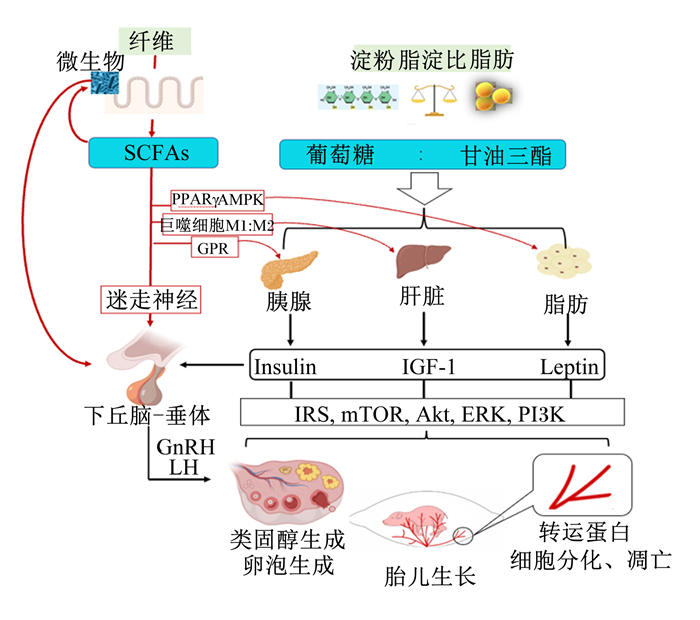
|
SCFAs:短链脂肪酸short chain fatty acids;GPR:G蛋白偶联受体G protein coupled receptor;PPARγ:过氧化物酶体增殖物激活受体γ peroxisome proliferators-activated receptor γ;AMPK:AMP活化蛋白激酶AMP-activated protein kinase:Insulin:胰岛素;IGF-1:胰岛素样生长因子-1 insulin-like growth factor-1;Leptin:瘦素;GnRH:促性腺激素释放激素gonadotropin-releasing hormone;LH:黄体生成素luteinizing hormone;IRS:胰岛素受体底物insulin receptor substrate;mTOR:哺乳动物雷帕霉素靶蛋白mammalian target of rapamycin;Akt:蛋白激酶B protein kinase B;ERK:细胞外调节蛋白激酶extracellular regulated protein kinases;PI3K:磷酸肌醇3-激酶phosphatidylinositide 3-kinase。 图 2 不同能量来源对母猪胎儿发育的影响 Fig. 2 Effects of different energy sources on fetal development in sows |
有关母猪饲粮蛋白质水平的研究集中在妊娠期和泌乳期。在后备母猪上仅有卓勇[49]的研究表明,蛋白质限制降低原始卵泡激活,蛋白质过量增加原始卵泡激活。综合当前研究[50-52]发现(图 3-A、图 3-B),妊娠期低蛋白质饲粮[10.5%粗蛋白质(CP)]可以满足繁殖性能、产仔性能的需要量[10],而15.56% CP的饲粮可以增加泌乳量[51];然而,过高的蛋白质水平有降低仔猪初生重和窝产仔数的趋势。图 3-C显示,泌乳母猪饲喂低蛋白质饲粮可降低仔猪断奶重,蛋白质水平超过13%以后,在氨基酸平衡时可基本满足母猪繁殖需要,但仔猪断奶重会受到影响。因此,对于1胎妊娠母猪,饲粮蛋白质水平达到13%即可满足营养需要,而适宜提高蛋白质水平可改善繁殖性能;对于泌乳母猪,为了维持适宜的体况,降低体储备的动员,标准回肠可消化粗蛋白质(SID CP)需求估计为135 g/kg或者850 g/d[53]。
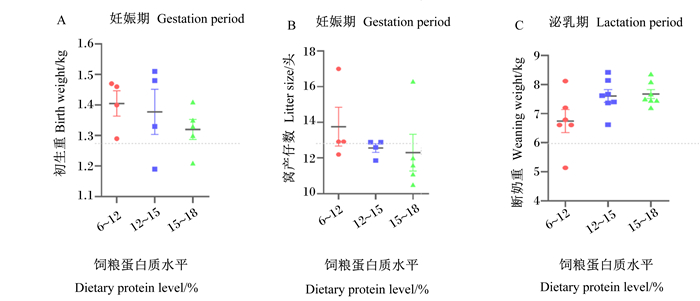
|
图 3 饲粮蛋白质水平对母猪繁殖性能的影响 Fig. 3 Effects of dietary protein level on reproductive performance of sows |
母猪蛋白质营养实际上是氨基酸营养,赖氨酸是玉米-豆粕型饲粮中的第一限制性氨基酸。图 4汇总了近期饲粮总赖氨酸与ME比值对母猪繁殖性能影响的相关研究[54-56],结果显示,对于妊娠母猪,饲粮总赖氨酸与ME比值在0.43~0.58 g/MJ时,仔猪初生重和母猪窝产仔数较高;对于泌乳母猪,饲粮总赖氨酸与代谢能比值在0.59~0.73 g/MJ时,仔猪断奶重较高。
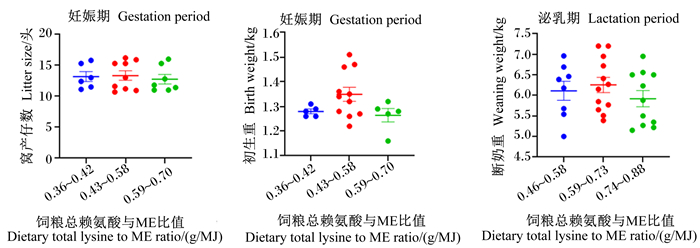
|
图 4 饲粮总赖氨酸与ME比值对母猪繁殖性能的影响 Fig. 4 Effects of dietary total lysine to ME ratio on reproductive performance of sows |
由图 5可以看出,氨基酸水平以及来源可影响母猪的繁殖性能,但不同氨基酸其作用机制存在差异。蛋氨酸不仅是蛋白质合成的底物之一,其转甲基代谢产物S-腺苷蛋氨酸(SAM)通过DNA甲基化转移酶等作用为DNA的甲基化修饰提供甲基供体(图 5)。适宜增加含硫氨基酸如蛋氨酸水平,可通过增强DNA甲基化修饰酶的作用改善胎儿发育,提高泌乳性能[57-58],但蛋氨酸水平过高可能会增加子代风险[59]。近年来,对支链氨基酸(BCAAs)开展了较多研究,研究发现,BCAAs可以通过哺乳动物雷帕霉素靶蛋白(mTOR)信号通路促进胎儿发育(图 5),改善乳汁成分,进而提高仔猪断奶重[60-62]。精氨酸不仅可以合成蛋白质,还可以代谢产生几种功能性产物,如多胺、肌酸和一氧化氮(NO)等(图 5),这些物质能够影响内分泌、免疫力,从而调节母猪的生殖能力。母猪饲粮中添加适宜水平的精氨酸可以促进胎儿发育,改善母猪繁殖力[63]。Hong等[64]的研究表明,添加高水平的精氨酸(饲粮精氨酸水平:1.5%),虽然精氨酸可提高初生窝重和泌乳期窝增重,提高低出生重胎儿成活率,但会降低仔猪均匀度。尽管当前开展了较多的母猪氨基酸的研究,然而有关不同生理阶段母猪氨基酸模式的研究较少,尤其是低蛋白质饲粮下的氨基酸模式更为值得关注。
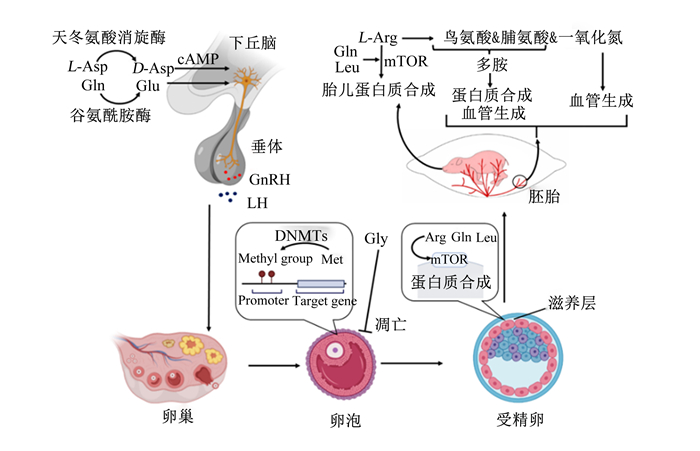
|
Asp: 天冬氨酸aspartic acid;Glu: 谷氨酸glutamic acid;Gln: 谷氨酰胺glutamine;Arg: 精氨酸arginine;Met: 蛋氨酸methionine;Leu:亮氨酸leucine;Gly:甘氨酸glycine;GnRH:促性腺激素释放激素gonadotropin-releasing hormone;LH:黄体生成素luteinizing hormone;DNMTs:DNA甲基转移酶DNA methyltransferases;mTOR:哺乳动物雷帕霉素靶蛋白mammalian target of rapamycin;Methyl group:甲基;Promoter:催化剂;Target gene:靶基因。 图 5 氨基酸对卵泡和胚胎发育的作用机理 Fig. 5 Mechanism of amino acids on follicle and embryo development |
能量和蛋白质是母猪饲粮中最重要的两大营养素,是维持母猪生命的基础,是促进卵母细胞成熟、胚胎与胎儿发育、乳腺功能的营养基础,对于母猪繁殖寿命和终身繁殖力具有关键调控作用。在当前人畜争粮矛盾、饲料资源被“卡脖子”的背景下,如何精准高效利用能量和蛋白质饲料资源任重道远。由于母猪繁殖生理的复杂性、影响因素的多样性、科学研究的连续性等问题,使得母猪能量和蛋白质的营养体系还存在诸多理论与技术难点亟待突破,如最佳的能量来源和比例、能量来源如何互作调控母猪繁殖性能、能蛋比与繁殖性能和繁殖寿命之间的关系、低蛋白质饲粮模式下氨基酸的平衡模式等。因此,进一步加强母猪能量和蛋白质营养基础理论研究,形成精准高效饲粮配方技术和产品,仍然是当前动物营养学界的重要任务。
| [1] |
JIN S S, JIN Y H, JANG J C, et al. Effects of dietary energy levels on physiological parameters and reproductive performance of gestating sows over three consecutive parities[J]. Asian-Australasian Journal of Animal Sciences, 2018, 31(3): 410-420. DOI:10.5713/ajas.17.0016 |
| [2] |
GOURLEY K M, SWANSON A J, DEROUCHEY J M, et al. Effects of increased lysine and energy feeding duration prior to parturition on sow and litter performance, piglet survival, and colostrum quality[J]. Journal of Animal Science, 2020, 98(5): skaa105. DOI:10.1093/jas/skaa105 |
| [3] |
CHOI Y, HOSSEINDOUST A, SHIM Y, et al. Evaluation of high nutrient diets on litter performance of heat-stressed lactating sows[J]. Asian-Australasian Journal of Animal Sciences, 2017, 30(11): 1598-1604. DOI:10.5713/ajas.17.0398 |
| [4] |
PEDERSEN T F, VAN VLIET S, BRUUN T S, et al. Feeding sows during the transition period—is a gestation diet, a simple transition diet, or a lactation diet the best choice?[J]. Translational Animal Science, 2020, 4(1): 34-48. DOI:10.1093/tas/txz155 |
| [5] |
KIM K Y, CHOI Y H, HOSSEINDOUST A, et al. Effects of free feeding time system and energy level to improve the reproductive performance of lactating sows during summer[J]. Journal of Animal Science and Technology, 2020, 62(3): 356. DOI:10.5187/jast.2020.62.3.356 |
| [6] |
ZOU T, YU B, YU J, et al. Moderately decreased maternal dietary energy intake during pregnancy reduces fetal skeletal muscle mitochondrial biogenesis in the pigs[J]. Genes & Nutrition, 2016, 11(1): 1-10. |
| [7] |
PARK M S, YANG Y X, CHOI J Y, et al. Effects of dietary fat inclusion at two energy levels on reproductive performance, milk compositions and blood profiles in lactating sows[J]. Acta Agriculturae Scand: Section A, 2008, 58(3): 121-128. |
| [8] |
ROSERO D S, VAN HEUGTEN E, ODLE J, et al. Response of the modern lactating sow and progeny to source and level of supplemental dietary fat during high ambient temperatures[J]. Journal of Animal Science, 2012, 90(8): 2609-2619. DOI:10.2527/jas.2011-4242 |
| [9] |
CONG R, JIA Y, LI R, et al. Maternal low-protein diet causes epigenetic deregulation of HMGCR and CYP7α1 in the liver of weaning piglets[J]. The Journal of Nutritional Biochemistry, 2012, 23(12): 1647-1654. DOI:10.1016/j.jnutbio.2011.11.007 |
| [10] |
FANG L H, JIN Y H, JEONG J H, et al. Effects of dietary energy and protein levels on reproductive performance in gestating sows and growth of their progeny[J]. Journal of Animal Science and Technology, 2019, 61(3): 154. DOI:10.5187/jast.2019.61.3.154 |
| [11] |
HEO S, YANG Y X, JIN Z, et al. Effects of dietary energy and lysine intake during late gestation and lactation on blood metabolites, hormones, milk compositions and reproductive performance in primiparous sows[J]. Canadian Journal of Animal Science, 2008, 88(2): 247-255. DOI:10.4141/CJAS07060 |
| [12] |
PEDERSEN T F, BRUUN T S, FEYERA T, et al. A two-diet feeding regime for lactating sows reduced nutrient deficiency in early lactation and improved milk yield[J]. Livestock Science, 2016, 191: 165-173. DOI:10.1016/j.livsci.2016.08.004 |
| [13] |
NOBLET J, ETIENNE M. Effect of energy level in lactating sows on yield and composition of milk and nutrient balance of piglets[J]. Journal of Animal Science, 1986, 63(6): 1888-1896. DOI:10.2527/jas1986.6361888x |
| [14] |
DOURMAD J Y, ETIENNE M, PRUNIER A, et al. The effect of energy and protein intake of sows on their longevity: a review[J]. Livestock Production Science, 1994, 40(2): 87-97. DOI:10.1016/0301-6226(94)90039-6 |
| [15] |
CASTAING J, COUDURE R, FEKETE J, et al. Contribution à la définition d'un rationnement énergétique de gestation: recherche d'un niveau optimum[J]. Journées Recherches Porcine en France, 1983, 15: 267-284. |
| [16] |
ZOBEL H F. Molecules to granules: a comprehensive starch review[J]. Starch/Stärke, 1988, 40(2): 44-50. DOI:10.1002/star.19880400203 |
| [17] |
ZHOU D S, FANG Z F, WU D, et al. Dietary energy source and feeding levels during the rearing period affect ovarian follicular development and oocyte maturation in gilts[J]. Theriogenology, 2010, 74(2): 202-211. DOI:10.1016/j.theriogenology.2010.02.002 |
| [18] |
林长光, 刘景, 刘亚轩, 等. 不同饲粮能量结构对后备母猪初情日龄、血清代谢产物和激素浓度的影响[J]. 动物营养学报, 2019, 31(6): 2891-2897. LIN C G, LIU J, LIU Y X, et al. Effects of different dietary energy structures on age of puberty, serum metabolite and hormone concentrations of replacement gilts[J]. Chinese Journal of Animal Nutrition, 2019, 31(6): 2891-2897 (in Chinese). |
| [19] |
MACHADO G S, FONTES D O, ALMEIDA F R C L, et al. Effects of different energy sources on ovulation rate, pregnancy rate and embryo survival in cyclic gilts[J]. Arquivo Brasileiro de Medicina Veterinária e Zootecnia, 2008, 60(3): 600-606. DOI:10.1590/S0102-09352008000300012 |
| [20] |
NEWCOMB M D, HARMON D L, NELSSEN J L, et al. Effect of energy source fed to sows during late gestation on neonatal blood metabolite homeostasis, energy stores and composition[J]. Journal of Animal Science, 1991, 69(1): 230-236. DOI:10.2527/1991.691230x |
| [21] |
VAN DER PEET-SCHWERING C M C, KEMP B, BINNENDIJK G P, et al. Effects of additional starch or fat in late-gestating high nonstarch polysaccharide diets on litter performance and glucose tolerance in sows[J]. Journal of Animal Science, 2004, 82(10): 2964-2971. DOI:10.2527/2004.82102964x |
| [22] |
WANG W H, WANG Z J, MING D X, et al. Effect of maternal dietary starch-to-fat ratio and daily energy intake during late pregnancy on the performance and lipid metabolism of primiparous sows and newborn piglets[J]. Journal of Animal Science, 2022, 100(4): skac033. DOI:10.1093/jas/skac033 |
| [23] |
THINGNES S L, GAUSTAD A H, KJOS N P, et al. Pea starch meal as a substitute for cereal grain in diets for lactating sows: the effect on sow and litter performance[J]. Livestock Science, 2013, 157(1): 210-217. DOI:10.1016/j.livsci.2013.06.023 |
| [24] |
YAN H, LU H, ALMEIDA V V, et al. Effects of dietary resistant starch content on metabolic status, milk composition, and microbial profiling in lactating sows and on offspring performance[J]. Journal of Animal Physiology and Animal Nutrition, 2017, 101(1): 190-200. DOI:10.1111/jpn.12440 |
| [25] |
YANG Y Y, DENG M, CHEN J Z, et al. Starch supplementation improves the reproductive performance of sows in different glucose tolerance status[J]. Animal Nutrition, 2021, 7(4): 1231-1241. DOI:10.1016/j.aninu.2021.03.010 |
| [26] |
YANG Y Y, HU C J, ZHAO X C, et al. Dietary energy sources during late gestation and lactation of sows: effects on performance, glucolipid metabolism, oxidative status of sows, and their offspring[J]. Journal of Animal Science, 2019, 97(11): 4608-4618. DOI:10.1093/jas/skz297 |
| [27] |
WEAVER A C, KELLY J M, KIND K L, et al. Oocyte maturation and embryo survival in nulliparous female pigs (gilts) is improved by feeding a lupin-based high-fibre diet[J]. Reproduction, Fertility, and Development, 2013, 25(8): 1216-1223. DOI:10.1071/RD12329 |
| [28] |
ZHUO Y, CAO M, GONG Y C, et al. Gut microbial metabolism of dietary fibre protects against high energy feeding induced ovarian follicular atresia in a pig model[J]. British Journal of Nutrition, 2021, 125(1): 38-49. DOI:10.1017/S0007114520002378 |
| [29] |
XU S Y, TANG L C, XU H T, et al. Effects of energy and dietary fiber on the breast development in gilt[J]. Frontiers in Veterinary Science, 2022, 9: 830392. DOI:10.3389/fvets.2022.830392 |
| [30] |
李浩. 妊娠后期饲粮中可溶性纤维对母猪繁殖性能、血液生化指标和肠道菌群结构的影响[D]. 硕士学位论文. 长沙: 湖南农业大学, 2020. LI H. Effects of dietary soluble fiber in late gestation on reproductive performance, blood biochemical indices and intestinal microbiota structure of sows[D]. Master's Thesis. Changsha: Hunan Agricultural University, 2020. (in Chinese) |
| [31] |
FEYERA T, HØJGAARD C K, VINTHER J, et al. Dietary supplement rich in fiber fed to late gestating sows during transition reduces rate of stillborn piglets[J]. Journal of Animal Science, 2017, 95(12): 5430-5438. DOI:10.2527/jas2017.2110 |
| [32] |
SAPKOTA A, MARCHANT-FORDE J N, RICHERT B T, et al. Including dietary fiber and resistant starch to increase satiety and reduce aggression in gestating sows[J]. Journal of Animal Science, 2016, 94(5): 2117-2127. DOI:10.2527/jas.2015-0013 |
| [33] |
TAN C Q, SUN H Q, WEI H K, et al. Effects of soluble fiber inclusion in gestation diets with varying fermentation characteristics on lactational feed intake of sows over two successive parities[J]. Animal, 2018, 12(7): 1388-1395. DOI:10.1017/S1751731117003019 |
| [34] |
颜川. 不同来源纤维或油脂添加对母猪繁殖性能及后代免疫功能的影响[D]. 硕士学位论文. 雅安: 四川农业大学, 2016. YAN C. The effect of different source of fiber or addition of soy oil on sow reproductive performance and immune function of offspring[D]. Master's Thesis. Ya'an: Sichuan Agricultural University, 2016. (in Chinese) |
| [35] |
FEYERA T, HU L, ESKILDSEN M, et al. Impact of four fiber-rich supplements on nutrient digestibility, colostrum production, and farrowing performance in sows[J]. Journal of Animal Science, 2021, 99(9): skab247. DOI:10.1093/jas/skab247 |
| [36] |
LIU Y, CHEN N, LI D, et al. Effects of dietary soluble or insoluble fiber intake in late gestation on litter performance, milk composition, immune function, and redox status of sows around parturition[J]. Journal of Animal Science, 2020, 98(10): skaa303. DOI:10.1093/jas/skaa303 |
| [37] |
张磊, 陆东东, 邓琳, 等. 饲粮添加可发酵纤维对母猪性能、血液生化指标及粪便质量的影响[J]. 中国畜牧杂志, 2020, 56(10): 117-123. ZHANG L, LU D D, DENG L, et al. Effects of dietary suplementation of fermentable fibers on performance, biochemical indicators in blood and faeces quality of sows[J]. Chinese Journal of Animal Science, 2020, 56(10): 117-123 (in Chinese). |
| [38] |
李扬. 纤维营养对妊娠母猪繁殖性能和肠道菌群的影响[D]. 博士学位论文. 雅安: 四川农业大学, 2019. LI Y. Effects of dietary fiber in gestation diet on sow reproductive performance and gut microbiota[D]. Ph. D. Thesis. Ya'an: Sichuan Agricultural University, 2019. (in Chinese) |
| [39] |
WANG L X, ZHANG S, JOHNSTON L J, et al. A systematic review and meta-analysis of dietary fat effects on reproductive performance of sows and growth performance of piglets[J]. Journal of Animal Science and Biotechnology, 2022, 13(1): 12. DOI:10.1186/s40104-021-00662-3 |
| [40] |
黄庆. 日粮中添加大豆油脂对母猪生产性能影响的研究[D]. 硕士学位论文. 长沙: 湖南农业大学, 2005. HUANG Q. Effects of soybean oil added in sow's diet on the production performances of the sows[D]. Master's Thesis. Changsha: Hunan Agricultural University, 2005. (in Chinese) |
| [41] |
褚婷婷. 亚麻油和鱼油对母猪生产性能、免疫机能和粪菌菌群结构的影响[D]. 硕士学位论文. 杨凌: 西北农林科技大学, 2021. CHU T T. Effects of linseed oil and fish oil on sow reproductive performance, immune function and fecal flora structure[D]. Master's Thesis. Yangling: Northwest A&F University, 2021. (in Chinese) |
| [42] |
LAURIDSEN C, DANIELSEN V. Lactational dietary fat levels and sources influence milk composition and performance of sows and their progeny[J]. Livestock Production Science, 2004, 91(1/2): 95-105. |
| [43] |
LAWS J, JUNIPER D T, LEAN I J, et al. Supplementing sow diets with palm oil during late gestation and lactation: effects on milk production, sow hormonal profiles and growth and development of her offspring[J]. Animal, 2018, 12(12): 2578-2586. DOI:10.1017/S1751731118000885 |
| [44] |
WEBEL S K, OTTO E R, WEBEL D M, et al. Effect of protected n-3 polyunsaturated fatty acids (FertiliumTM) on litter size in sows[J]. Journal of Animal Science, 2003, 81(18): 15000403. |
| [45] |
SPENCER J D, WILSON L, WEBEL S K, et al. Effect of feeding protected n-3 polyunsaturated fatty acids (FertiliumTM) on litter size in gilts[J]//Journal of Animal Science, 2004, 82: 81-81.
|
| [46] |
NGUYEN T X, AGAZZI A, MCGILL S, et al. Abundance of plasma proteins in response to divergent ratios of dietary ω6∶ω3 fatty acids in gestating and lactating sows using a quantitative proteomics approach[J]. Journal of Proteomics, 2022, 260: 104562. DOI:10.1016/j.jprot.2022.104562 |
| [47] |
FERREIRA R F, BLEES T, SHAKERI F, et al. Effects of different ratios of omega-6∶omega-3 fatty acids in the diet of sows on the proteome of milk-derived extracellular vesicles[J]. Journal of Proteomics, 2022, 264: 104632. DOI:10.1016/j.jprot.2022.104632 |
| [48] |
YAO W, LI J, WANG J J, et al. Effects of dietary ratio of n-6 to n-3 polyunsaturated fatty acids on immunoglobulins, cytokines, fatty acid composition, and performance of lactating sows and suckling piglets[J]. Journal of Animal Science and Biotechnology, 2012, 3(1): 43. DOI:10.1186/2049-1891-3-43 |
| [49] |
卓勇. FGF21-脂联素分泌轴介导蛋白质营养调控卵巢原始卵泡激活[D]. 博士学位论文. 雅安: 四川农业大学, 2018. ZHUO Y. Control of ovarian primordial follicle activation by dietary protein requires an FGF21-adiponection axis[D]. Ph. D. Thesis. Ya'an: Sichuan Agricultural University, 2018. (in Chinese) |
| [50] |
HOVING L L, SOEDE N M, VAN DER PEET-SCHWERING C M C, et al. An increased feed intake during early pregnancy improves sow body weight recovery and increases litter size in young sows[J]. Journal of Animal Science, 2011, 89(11): 3542-3550. DOI:10.2527/jas.2011-3954 |
| [51] |
PEDERSEN T F, CHANG C Y, TROTTIER N L, et al. Effect of dietary protein intake on energy utilization and feed efficiency of lactating sows[J]. Journal of Animal Science, 2019, 97(2): 779-793. DOI:10.1093/jas/sky462 |
| [52] |
JANG Y D, JANG S K, KIM D H, et al. Effects of dietary protein levels for gestating gilts on reproductive performance, blood metabolites and milk composition[J]. Asian-Australasian Journal of Animal Sciences, 2014, 27(1): 83-92. DOI:10.5713/ajas.2013.13369 |
| [53] |
STRATHE A V, BRUUN T S, GEERTSEN N, et al. Increased dietary protein levels during lactation improved sow and litter performance[J]. Animal Feed Science and Technology, 2017, 232: 169-181. DOI:10.1016/j.anifeedsci.2017.08.015 |
| [54] |
THOMAS L L, HERD L K, GOODBAND R D, et al. Effects of increasing standardized ileal digestible lysine during gestation on reproductive performance of gilts and sows[J]. Animal, 2021, 15(7): 100221. DOI:10.1016/j.animal.2021.100221 |
| [55] |
HOJGAARD C K, BRUUN T S, THEIL P K. Optimal lysine in diets for high-yielding lactating sows[J]. Journal of Animal Science, 2019, 97(10): 4268-4281. DOI:10.1093/jas/skz286 |
| [56] |
HONG J S, FANG L H, KIM Y Y. Effects of dietary energy and lysine levels on physiological responses, reproductive performance, blood profiles, and milk composition in primiparous sows[J]. Journal of Animal Science and Technology, 2020, 62(3): 334-347. DOI:10.5187/jast.2020.62.3.334 |
| [57] |
XIA M, PENG J, CUI C B, et al. Effect of gestation dietary methionine-to-lysine ratio on methionine metabolism and antioxidant ability of high-prolific sows[J]. Animal Nutrition, 2021, 7(3): 849-858. DOI:10.1016/j.aninu.2021.02.006 |
| [58] |
ZHANG Y, XU B Y, ZHAO L, et al. Increased consumption of sulfur amino acids by both Sows and piglets enhances the ability of the progeny to adverse effects induced by lipopolysaccharide[J]. Animals, 2019, 9(12): 1048. DOI:10.3390/ani9121048 |
| [59] |
AZAD M A K, LIU G, BIN P, et al. Sulfur-containing amino acid supplementation to gilts from late pregnancy to lactation altered offspring's intestinal microbiota and plasma metabolites[J]. Applied Microbiology and Biotechnology, 2020, 104(3): 1227-1242. DOI:10.1007/s00253-019-10302-6 |
| [60] |
WANG C X, CHEN F, ZHANG W F, et al. Leucine promotes the growth of fetal pigs by increasing protein synthesis through the mTOR signaling pathway in longissimus dorsi muscle at late gestation[J]. Journal of Agricultural and Food Chemistry, 2018, 66(15): 3840-3849. DOI:10.1021/acs.jafc.8b00330 |
| [61] |
REZAEI R, GABRIEL A S, WU G Y. Dietary supplementation with branched-chain amino acids enhances milk production by lactating sows and the growth of suckling piglets[J]. Journal of Animal Science and Biotechnology, 2022, 13(1): 65. DOI:10.1186/s40104-022-00718-y |
| [62] |
MA C, LIU Y, LIU S S, et al. Branched chain amino acids alter fatty acid profile in colostrum of sows fed a high fat diet[J]. Journal of Animal Science and Biotechnology, 2020, 11: 9. DOI:10.1186/s40104-019-0423-9 |
| [63] |
DA SILVA FONSECA L, LANFERDINI E, MOREIRA R H R, et al. Arginine supplementation in the feed of gestating sows[J]. Livestock Science, 2022, 263: 104999. DOI:10.1016/j.livsci.2022.104999 |
| [64] |
HONG J S, FANG L H, JEONG J H, et al. Effects of L-arginine supplementation during late gestation on reproductive performance, piglet uniformity, blood profiles, and milk composition in high prolific sows[J]. Animals, 2020, 10(8): 1313. DOI:10.3390/ani10081313 |



